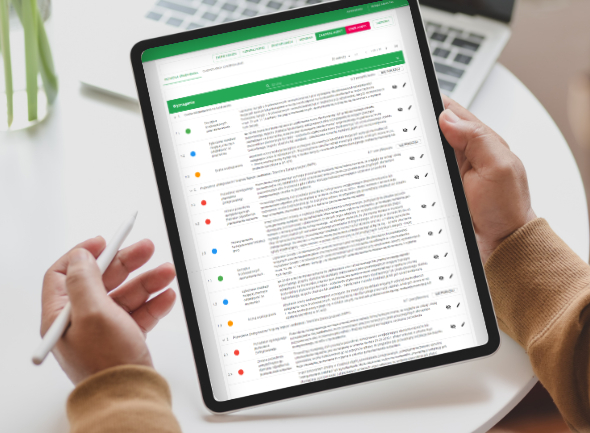Audit Management Platform

About Client
The company provides consulting in compliance with legal standards and regulations for enterprises. The core of its activity is advice on meeting legal requirements. It also carries out audits checking the company’s compliance with, for example, health and safety standards. The Client has been in the industry for over 20 years and boasts 1,000 customers. The company team spent 10,000 days conducting conformity assessment audits. Thanks to that experience, the client works to the highest standards of consulting.
Project challenges
- The client was overloaded with manual work during the audit process. The preparation for each audit took several hours because it was necessary to choose the legal requirements appropriate for a particular client.
- The client was non-technical - they were looking for a partner who would help them to carry out the whole software development process, from analysis, wireframes, and development to maintenance and support.
- Data was stored in form, which made it difficult to use. There was no possibility of interaction, e.g. allowing the client to include in the audit their own comments and statuses.
- Offline mode was required: the software also needed to facilitate the work of auditors on-site in the factories (where the internet is not always stable).
- It was also important to ensure business continuity. The client used its own legacy requirements database for identification of their clients’ legal requirements.ts That application was not used often, and the Client was worried about losing their position in the market.
- Another element to consider was an increase in new sales. A web Application could open a new omnichannel to users, who will use the application and allow Client to contact them.
Solution and technology

Preparing and executing an audit, as well as presenting results to the client, requires a modern, cloud based solution. Auditors should be provided with a platform that automates some of their efforts to select the rules that companies must comply with. This changes over time, meaning auditors need access to the newest version of regulations while bearing comments from previous audits in mind.
Using an Excel version was difficult. . The software should also facilitate the work of auditors on-site in factories (where the internet is not always stable) and allow the client to access audit results online.
We created a Progressive Web App (PWA) application because it can be used on both tablet and computer. The tablet was to be used during the auditor’s work on-site, with the added benefit of being able to take photos.
A PWA also allows us to implement an offline mode. This was important for the Client because often, during audits on clients’ premises (e.g. in warehouses), advisers had problems with access to the network. Offline mode could run smoothly even when the connection was unstable.
The offline functionality works by caching content while a user has access to the network. When the device loses the connection, data is read from the cache.
Thanks to our application, the clients of the auditor’s company can see the results of the audit online more quickly. They also learn if there are changes in regulations regarding a specific matter that was inspected.
They will see the overall compliance rate of their facility with the law and may decide to order a further new audit. Our client (the auditor’s company) thus gained another sales channel.
The audit results available in the application also allow companies to interact internally and with the auditor. Upon receiving inspection results, they often repair problems in their facilities that resulted in non-compliance with the law. Then they can use the application to show that the imperfections have already been repaired and, in their opinion, the facilities already meet the legal requirements in specific areas.
For the company’s auditors, using the application represented a huge saving of time. . Preparing a list of requirements for a client in Excel, which previously took up to several hours, was shortened to seconds. For example, the auditor can select a set of requirements according to the scope (e.g. fire protection, environmental protection). Instead of looking for requirements in the database, they receive a list of them immediately.
Technologies applied:
- Progressive Web App (PWA)
- React
- .NET Core
- Entity Framework
- Azure Cloud
Delivery process
The client came to our company with an outline of the idea for the application. . They defined their basic requirements, but didn’t detail a technical approach.
Our job was, therefore, to create a complete concept of application. Our business analyst, project manager and technical leader took care of it. They worked on writing the requirements, clarifying the vision and preparing the application’s mockups. The visual form of the concept helped a lot in making it understandable for the client. It took a month to complete these tasks.
The client agreed to implementing the concept. After we had planned the work, he had one remark – the application was supposed to work offline. He was not aware that this change had a great importance to us because we had to change the entire solution architecture and technology.
We are fluent in many technologies, so we could meet this requirement. In addition, we work in the agile methodology, which allows us to adapt to client needs. It took us two weeks to reorganize the architecture and start the project.
Responsible for creating the application was a team comprising a project manager, business analyst, front-end developer working in React and a back-end developer using .Net. On the client’s side was a product owner.
We used the SCRUM methodology, two weeks sprint, demo after each sprint. The development of “phase 1” took 3 months.
After this time, however, there were comments from users who were ultimately supposed to use the application. As those comments did not appear during development, we were forced to hand over the application in a developed form and introduce further adjustments at the support stage.
Results
The project delivered tangible benefits for the client:
- Reducing the time of preparing an audit from several hours to a few seconds.
Execution of an audit is also faster, allowing users to interact with the results of audits - Creating an additional sales channel,
- Creating a base for future enhancement and a place where other legacy systems can be migrated
For us, working on this project was an interesting experience. It allowed us to appreciate even more the advantages of the agile methodology, enabling a flexible response to changes. We also checked our ability to quickly change the direction of the project. Most of all, we are satisfied with the shape of the completed project.
Sound like the right fit for you, too?

Rite NRG gives you high-performing, nearshored developers who fit your culture, ready to go as soon as you are.
Talk to us to find out more.
Michał Nikołajuk
Chief Executive Officer
